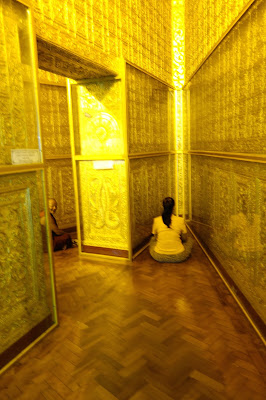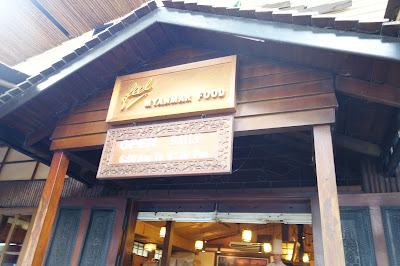
After a morning of architectural sightseeing, it was time for lunch. Although there is no shortage of authentic Burmese restaurants in Yangon, Feel Myanmar is probably the city’s best place to sample Burmese food. Food is laid out in a big buffet spread at the back of the restaurant. I asked Myo if we could stop there and eat, and invited him to join us for lunch. Our meal was HUGE. They just kept bringing out plate after plate of food.
I’ll will never get used to how inexpensive food is here in Burma. All this food. Three people. $14.



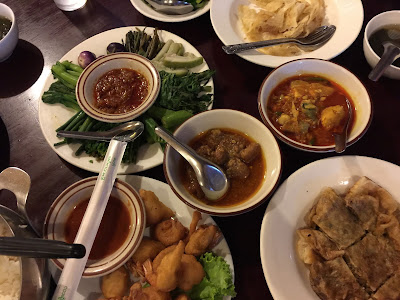
The first (of many, many) pagodas on our trip was the Botataung Pagoda.

This beautiful pagoda is revered by Buddhists as the resting place of some very sacred relics. Two millennia ago, all 8 of the Buddha’s hairs said to have been brought to Burma from India during his lifetime were kept here, protected by a 1000-strong army. (The name Botataung can be broken into “bo” [soldier] and “tataung” [thousand]) Only one hair remained, which was secreted inside the stupa along side many other precious objects, until the building was hit by a bomb during WWII. When they reconstructed the stupa, a few precious relic chambers were found, containing an amazing treasure trove of 700 items including precious stones, jewelry, gold, silver and brass statues, and a pure gold stupa-shaped chamber containing pieces of bone and a single strand of hair. These are now in the hollow interior. (The original stupa was solid. When it was rebuilt after the war, it was hollow.)

Natives enter for free. Foreigners have to pay a fee.
Dogs enter for free.
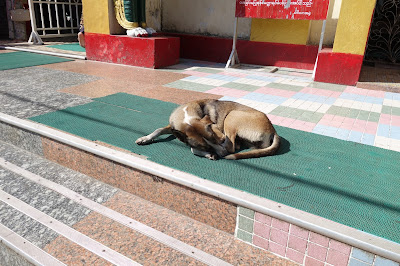
The corridor running through the inside of the stupa is elaborately decorated, the walls and ceilings covered in gilded panels.

At the center of the stupa is a spectacularly embellished little shrine containing the Buddha’s hair relic, along with some of the other items from that excavated relic chamber. The relic is shoved in a very narrow corner of the temple, with people crowding for a glimpse, though a tiny slit in the glass, like you might see at a bank teller’s station. People get up there, take a quick gander, and then throw money in there. There was buckets of money in there. Scattered amongst
the visitors were a few devout Buddhists who prayed and were genuinely moved.


There’s me and Mark, and there’s our guide, Myo.

The side hall on the western side of the terrace houses a gilded bronze Buddha from the Konbaung era. (The terrace is unusually large for a pagoda.)
 In the southwest corner of the inner courtyard is the temple’s nat shrine, which includes an image of the pagoda’s white-turbaned nat guardian, Bo Bo Gyi (“great grandfather”).
In the southwest corner of the inner courtyard is the temple’s nat shrine, which includes an image of the pagoda’s white-turbaned nat guardian, Bo Bo Gyi (“great grandfather”).
There were numerous shrines all around the terrace surrounding the pagoda.
I did see a few kitties at the pagoda. This little one was shy and avoiding people.

At this shrine, people were paying respects to the Buddha images. A kitten suddenly came out and settled down between the man and the woman.
Also on the terrace was a lovely gilded corridor. This was a walkway, below which were turtles in the water. People were feeding the turtles.

Sometimes, the simplest things seem to give the most satisfaction. Like just sitting there, relaxing, eating a bag of tangerines.

I spotted another cat on the premises. Very friendly. Immediately sat in my lap.
The final room we visited on the terrace was a weaving room. The constant rhythmic banging of the looms was the soundtrack, as the woman there wove the saffron-colored cloths that are used to shroud many of the Buddha statues.
 We left the Botataung and met up with our driver, who was waiting out front for us in the air conditioned car. Thank goodness. It was 96 degrees and very humid. Our next stop was the Sule Pagoda, right in the heart of downtown.The Sule Pagoda is the most visible of all Burmese temples. All streets downtown seem to converge toward this defining landmark. In fact, all distances to other parts of the nation are still measured from this pagoda, like a Burmese version of London’s Charing Cross. It looks lonely during the day, marooned within a busy roundabout, surrounded by hectic traffic, internet cafes, print studios, and dozens of shops, but at night, it’s amazingly beautiful when illuminated.
We left the Botataung and met up with our driver, who was waiting out front for us in the air conditioned car. Thank goodness. It was 96 degrees and very humid. Our next stop was the Sule Pagoda, right in the heart of downtown.The Sule Pagoda is the most visible of all Burmese temples. All streets downtown seem to converge toward this defining landmark. In fact, all distances to other parts of the nation are still measured from this pagoda, like a Burmese version of London’s Charing Cross. It looks lonely during the day, marooned within a busy roundabout, surrounded by hectic traffic, internet cafes, print studios, and dozens of shops, but at night, it’s amazingly beautiful when illuminated.
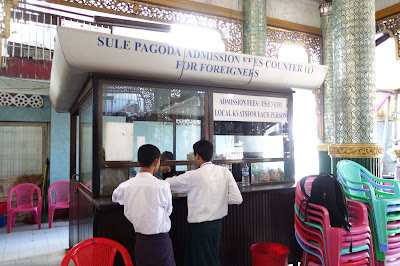 Locals get in free. Foreigners have to pay
Locals get in free. Foreigners have to pay
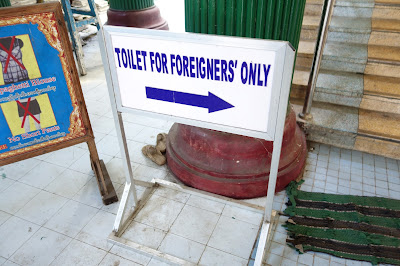
But at least foreigners get a nicer toilet
.
According to local tradition, the pagoda was built during the lifetime of the Buddha himself. Supposedly, the 43 meter high stupa is said to enshrine one of the Buddha’s hairs, given by the Buddha himself to the brothers Tapissa and Balika, two merchants from Myanmar.

The Sule Pagoda served as an important rallying point for pro-democracy activists during the 1988 uprising, and the 2007 so-called “Saffron Revolution”. During the latter, nine people were brutally massacred when the military opened fire on unarmed protestors. Four staircases lead up to the pagoda from each of the cardinal points, with four matching shrines attached to the base of the stupa at the top of each flight of stairs. The construction of the pagoda differs from most other Burmese stupas. It sits on an octagonal base, following the standard Burmese design, but then, the bell and spire of the stupa continue the octagonal shape, rather than following the circular pattern seen in just about every other Burmese stupa. We took this staircase to the top You emerge on a terrace which is dotted with many small shrines and temples, each containing some sort of object of devotion, whether a statue of the Buddha, or one of the nat spirits protect over the pagoda.


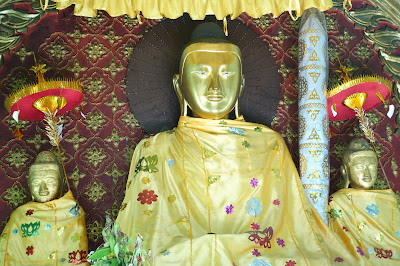

We saw a man devotedly applying gold leaf to one of the statues.
And lots of Buddhas and other statues in the little temples all around the terrace.


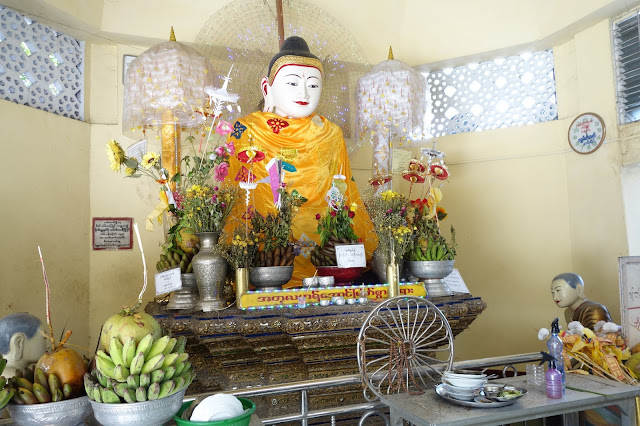
Time to leave the downtown, finally, and head a little north. Our ultimate destination was the Shwedagon Pagoda, but before heading there, we were going to stop at an impressive seated Buddha, and an equally impressive reclining Buddha.

In this temple, called Nga Hta Gyi, you’ll find one of Burma’s most imposing seated Buddhas. Not quite the equal of the nearby Chauk Htat Gyi one (our next stop), but the elaborate decoration makes up for it. Sometimes called the “Five-Story Buddha”, this pale-faced statue dates from 1558. The hall he rests in was built in 1930. He is known for his richly bejeweled crown and intricately carved golden robes, and especially the flame-like armor emanating from his body, and the amazingly detailed carved wood backdrop against which he sits. He is sitting in the earth-witness mudra, brushing the ground lightly with his enormous pink fingernails. The windows set in the raised ceiling above his head illuminates him dramatically.

In addition to the huge Buddha, there are displays of other statues and bells nearby, which were also pretty cool. I liked this Buddha with the monks following behind.
Some of the Buddha statues are adorned with cheese LED halos. I think it looks silly.
I like how, in the midst of everything, this monk was just sitting there quietly, contemplating the statue.
There was a large bell nearby, with neat Burmese writing engraved on the side. And, over by the area where you leave your shoes, I made friends with a little cat that was resting quietly. Resting quietly seems to be a theme here in Burma. It’s something very alien to a New Yorker. I could get used to it, though.
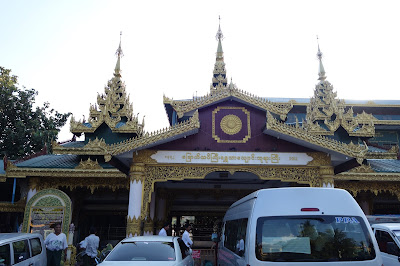
Very close by was the Chaukhtatgyi Paya, sometimes spelled Chauk Htat Gyi or Kyauk Htat Gyi.
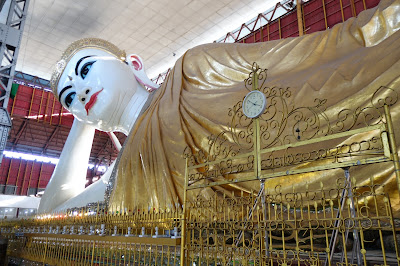
Even in a country filled with huge Buddhas, the giant reclining Buddha at Chauk Htat Gyi Pagoda is a real show-stopper. It’s almost 70 meters long (almost 230 feet). The figure was begun in 1959, after an earlier giant seated Buddha on the same site was demolished in 1957. It was completed in 1974. You can see a photo of the first one, labeled “Wingaba, Rangoon” in front of the reclining image. The name of the pagoda means “Six-story Pagoda” refers to this impressively huge seated statue.
This Buddha is kind of effeminate, face-wise, with the blue eye shadow and the supersized eyelashes (each lash is 33 cm long!)
The soles of the huge feet are divided into squares and inscribed with 108 auspicious golden markings.
There was a plaque nearby explaining the significance of all the markings
There were a lot of animals in this pagoda. These dogs:
 This mellow kitty
This mellow kitty
This cat, chilling on a mat near a guy praying to the statue in the glass case…
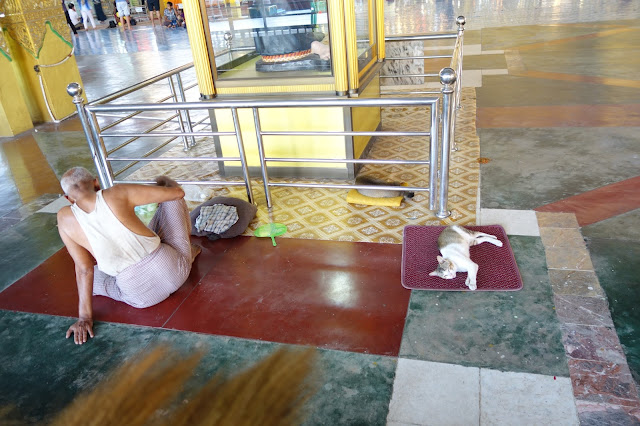
And this mama kitty and her little babies. I couldn’t resist picking up one of her kittens.

We left the reclining Buddha, and quickly popped by Kandawgi Park/Lake. This expanse of water, with its convoluted shore, is wrapped up in attractively landscaped gardens and surrounded by some primo real estate. The name translates as “Great Royal Lake” and was created by the British using water channeled from Inya Lake. It’s 8 km in circumference, but not much more than 1 meter deep at any point. The best views of the water are from Yeik Thar Road on the southern side, either from an attractive boardwalk or from the adjacent public road (which the government generously lets tourists use free of charge, although an ugly fence separates you and the lake.) That’s where these pictures were taken.
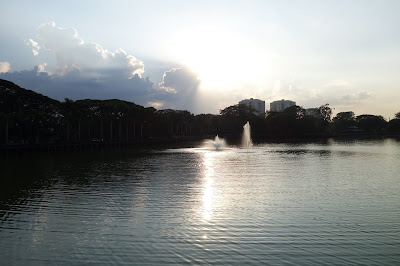
The leafiest area of Kandawgyi Lake is along the northern shore, encompassed by the Bogyoke Aung San Park. This public garden is laid out around the two-story former home of General Aung San and his wife, Daw Khin Kyi. It now holds a small museum dedicated to the memory of the man who was the architect of Burmese independence. A bronze statue of Aung San stands at the entrance to the gardens. That’s what you see across the lake.
The boardwalk is a popular spot. We saw a wedding taking place. According to our guide, weddings here are very common.
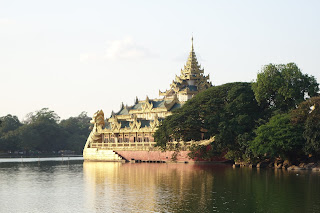
On the southeast side of Kandawgyi Lake is the striking Karaweik Palace, a chintzy pagoda-style hall built by the government, in 1974 to resemble the royal barges on which the Konbaung kings used to travel on the Ayeyarwady River. It’s set on a pair of barges that point out into the water, each with the head of an enormous karaweik (a mythical bird famous for its melodious song) on its prow. It’s a great place watch the sun set over the Shwedagon Pagoda, which is beautifully reflected on the lake. It’s quite a party zone in the evening, where the city’s young, hip, and rich come to eat, drink and relax, while the Shwedagon’s reflection shimmers in the water.

It’s also a restaurant, and they have a show there every night with traditional music and dancing. We did not attend the show, but the place itself was pretty impressive.
By now, it was 4:00 p.m. Time to head over to the most amazing, incredible pagoda of them all, the Shwedagon. We needed to get moving, because you want to be at the Shwedagon at sunset, which occurred this day at 5:30 p.m.
The Shwedagon deserves an entire blog post of its own.
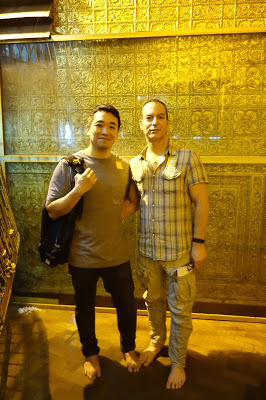
In the southwest corner of the inner courtyard is the temple’s nat shrine, which includes an image of the pagoda’s white-turbaned nat guardian, Bo Bo Gyi (“great grandfather”).
We left the Botataung and met up with our driver, who was waiting out front for us in the air conditioned car. Thank goodness. It was 96 degrees and very humid. Our next stop was the Sule Pagoda, right in the heart of downtown.The Sule Pagoda is the most visible of all Burmese temples. All streets downtown seem to converge toward this defining landmark. In fact, all distances to other parts of the nation are still measured from this pagoda, like a Burmese version of London’s Charing Cross. It looks lonely during the day, marooned within a busy roundabout, surrounded by hectic traffic, internet cafes, print studios, and dozens of shops, but at night, it’s amazingly beautiful when illuminated.
Locals get in free. Foreigners have to pay
 In this temple, called Nga Hta Gyi, you’ll find one of Burma’s most imposing seated Buddhas. Not quite the equal of the nearby Chauk Htat Gyi one (our next stop), but the elaborate decoration makes up for it. Sometimes called the “Five-Story Buddha”, this pale-faced statue dates from 1558. The hall he rests in was built in 1930. He is known for his richly bejeweled crown and intricately carved golden robes, and especially the flame-like armor emanating from his body, and the amazingly detailed carved wood backdrop against which he sits. He is sitting in the earth-witness mudra, brushing the ground lightly with his enormous pink fingernails. The windows set in the raised ceiling above his head illuminates him dramatically.
In this temple, called Nga Hta Gyi, you’ll find one of Burma’s most imposing seated Buddhas. Not quite the equal of the nearby Chauk Htat Gyi one (our next stop), but the elaborate decoration makes up for it. Sometimes called the “Five-Story Buddha”, this pale-faced statue dates from 1558. The hall he rests in was built in 1930. He is known for his richly bejeweled crown and intricately carved golden robes, and especially the flame-like armor emanating from his body, and the amazingly detailed carved wood backdrop against which he sits. He is sitting in the earth-witness mudra, brushing the ground lightly with his enormous pink fingernails. The windows set in the raised ceiling above his head illuminates him dramatically.
